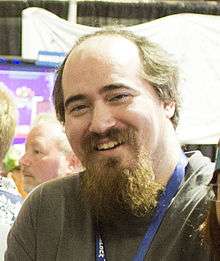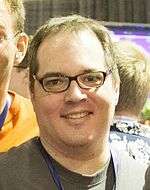Tarn Adams
| Tarn Adams | |
|---|---|
 Adams at PAX 2013 | |
| Born |
April 17, 1978 Silverdale, Washington, U.S. |
| Alma mater |
University of Washington (BSc) Stanford University (PhD) |
| Occupation | Computer game programmer |
| Years active | 1996–present |
Tarn Adams (born April 17, 1978) is an American computer game programmer, best known for his work on Dwarf Fortress. He has been working on it since 2002 with his older brother Zach. He learned programming in his childhood, and has been designing computer games as a hobby. He quit his first year of a mathematics post doctorate at Texas A&M to focus on game development in 2006.
Early life and education
Adams was born in Silverdale, Washington, US, in 1978. His father, Dan, worked at a waste water treatment plant and used to manage data. Adams credited his father for teaching him to code and his closeness to his brother, Zach, to their family's constant shifting due to their father's work. Adams and Zach grew up playing computer games and, with notebooks in hand, drawing their own renditions of the randomly generated creatures they encountered and logging their journeys in detail. In fifth grade, he wrote his first animation game with Zach. Explaining his reluctance to socialize,[1] he said, "I was a get-home-from-school, get-on-the-computer kind of kid." Adams stated that the main reason they started writing games was to be able to play them themselves, and complicated and unpredictable behavior guaranteed replayability.[2]
In high school they created a spacecraft game that simulated sections of a rocket blowing off and released their first publicly available game on America Online.[3] In sixth grade, they started their first fantasy game called dragslay written in BASIC. It consisted of single battles leading to a final one with a dragon. A few years later, he rewrote it in C language, and it featured minute details and kept track of populations of units in the world generated.[4]
After dragslay, they started working on another adventure game, focusing on world generation.[5] The role-playing video game Ultima inspired him regarding world development. For four years, after working on the adventure tile and rendering it in 3D graphics, they completed Slaves to Armok: God of Blood. "Armok" was the name of the game's deity from the variable "arm_ok", which was used in dragslay to indicate how many arms were left on a particular unit. The random story generator was originated by both of them writing stories.[4] Adams said, "you could zoom in on your character, and it’d tell you how curly his leg hairs were, and the melting and flash points of various materials, It was insane."[1] They posted it on their website in 2000 and by 2004 but the project started to face increasing problems. Adams announced in 2004 on his forums that he was going to shift his main project from Armok to a side project called Dwarf Fortress.[2]

Adams earned a degree in mathematics at the University of Washington.[1] He applied for his doctorate at Stanford University, completing it in 2005 with a dissertation titled "Flat Chains in Banach Spaces", which was published in The Journal of Geometric Analysis. During his first year at Stanford, he said he was under pressure, the professional environment and competitiveness affected him negatively. He cited the conflict between studying mathematics and developing video games as the reason. This stressful situation left him depressed and he admitted to having a brief encounter with drugs.[1]
Shift to game development
Adams and his brother started a company called Bay 12 Games, where they posted freeware games and attracted a small following. Adams assumed the name "Toady One" and his brother "ThreeToe". Adams' background in mathematics helped in algorithms with spatial considerations. With his skill in programming and Zach's background in ancient history and storytelling, together they designed and developed various projects.[2] They worked on some other small projects during graduation which were released on their website. Adams put up a PayPal button after a request from a fan; similarly, a subscriber system was added later. In the next five months, they made around $300, which brought in only enough to cover their site's $20 hosting cost.[3] He made side projects like Corin and Kobold Quest in a few days and Squiggles was made in three hours. He developed other games such as Liberal Crime Squad and WWI Medic.[4]
In 2006, he started his post doctorate in Texas A&M, which was his goal since his undergraduate days. He decided to leave during the first year due to the increasingly stressful situation[2] and is said to have broken down in the head of department's office.[1] After being offered to stay another year and a $50,000 stipend, he agreed and eventually left to devote his full attention to developing Dwarf Fortress and other games, which was until then only a hobby. He said, "At the end of a math problem, you have a paper and maybe you publish it, and the paper can be a building block for the edifice of mathematics, but to me that’s not so important. But working on a problem and having a game when you’re done? That’s pretty damn cool."[1]
Dwarf Fortress
After quitting the university, Adams thought he would use up his savings $15,000 for a year and need a job to sustain himself. Dwarf Fortress was originally started in October 2002 as a two-month side project, but was suspended soon after in preference over Armok's development. He had developed a game called Mutant Miner. It was turn-based game where players look for minerals and dig out tunnels while dealing with threats. He realized the need to be able to manage many miners and not only have a high score list, but also store more minute details, which was the beginning of the project.[1]
The primary game mode is set in a procedurally generated fantasy world in which the player indirectly controls a group of dwarves, and attempts to construct a successful and wealthy underground fortress.[6] Its development continued till 8 August 2006, when the first alpha version was released. Donations reached $800–$1000 in the following months, this average increased gradually until they were financially stable.[2] He then decided to solely rely on donations. The game eventually got a cult following and various web communities devoted to it were formed. Videogame journalists later covered his work. They focused on it being a two-member project surviving through donations. Critics praised its complex, emergent gameplay but had mixed reactions to its difficulty.[7][8]
The game has text-based graphics and is open-ended with no main objectives. It is a part construction and management simulation and part roguelike game due to its secondary game Adventure mode. Before playing, the player has to generate worlds with continents, oceans and histories documenting civilizations. The main game mode, Fortress mode, consists of selecting a suitable site from the generated-world, establishing a successful colony or fortress, combating threats like goblin invasions, generating wealth and taking care of the dwarves. Each dwarf is modeled down to its individual personality, has likes or dislikes and specific trainable skills in various labors.[8] The second main game mode, Adventure mode, is a turn-based, open-ended roguelike where the player starts off as an adventurer in the world and is free to explore, complete quests, or even visit old abandoned fortresses.[9] The combat system is anatomically detailed with combat logs describing organs getting pierced, fat getting bruised and limbs getting severed.[10][11]
Continuing it development, Adams calls it his life's work and said in 2011, that version 1.0 will not be ready for at least another 20 years, and even after that he would continue to work on it. The game influenced Minecraft and was selected among other games to be featured in the Museum of Modern Art to show the history of video gaming in 2012.[1] The game's fan following are an active community and Adams said they helped him in development besides giving monetary support.[12] Fans made creative interpretations of the game. He and his brother send crayon drawings or short stories to the donors, customized to their requests and display the highest donors on their website.[1]
Personal life
He cited books, movies, pen and paper role-playing games and other computer games, during their childhood, as inspiration for the various games developed.[5] He said that Dungeons & Dragons, works of J.R.R. Tolkien and videogames like Cyberpunk 2020 interested him,[1] with fantasy and sci-fi being heavily influential. On Dwarf Fortress' wound-based system rather than regular hitpoints, he said, "Hit points are depressing to me. It's sort of a reflex to just have HP/MP, like a game designer stopped doing their job...You should really question all of the mechanics in the game from the bottom up."[4] He said he does not use version control for his works.[13]
Regarding his career, he said, "...but as far as design is concerned, I just think that I've happened to fall into a little sweet spot where I get a lot of freedom, but I guess the cost is my livelihood."[3] He further said working in the gaming industry is "soul crushing".[5]
Adams has shown his dislike for massively multiplayer online games and said that popular games are addictive because they make use of the player's compulsive hoarding trait.[1]
References
- 1 2 3 4 5 6 7 8 9 10 11 Jonah Weiner (21 July 2011). "The Brilliance of Dwarf Fortress". New York Times. Retrieved 27 May 2012.
- 1 2 3 4 5 Jaz McDougall (2 August 2010). "Community heroes: Tarn Adams, for Dwarf Fortress". PC gamer. Retrieved 18 June 2013.
- 1 2 3 Chris LaVigne (4 March 2008). "For the Love of the Game". The Escapist. Retrieved 18 June 2013.
- 1 2 3 4 John Harris (27 February 2008). "Interview: The Making Of Dwarf Fortress". Gamasutra. Retrieved 18 June 2013.
- 1 2 3 Elijah Meeks (22 December 2010). "An Interview with Tarn Adams". Stanford University. Retrieved 18 June 2013.
- ↑ Kieron Gillen (18 February 2011). "The Very Important List of PC Games, Part 5/5". Rock, Paper, Shotgun. Retrieved 13 May 2014.
- ↑ Johnston, Casey (25 February 2013). "Dwarf Fortress: Ten hours with the most inscrutable video game of all time". Ars Technica. Archived from the original on 2014-08-12. Retrieved 12 May 2014.
- 1 2 Alex Spencer (26 Dec 2013). "A History of Roguelikes in 6 Free Games". IGN. Archived from the original on 2014-04-13. Retrieved 15 May 2014.
- ↑ Pearson, Dan (31 January 2013). "Where I'm @: A Brief Look at the Resurgence of Roguelikes". GameIndustry.biz. Archived from the original on 2014-09-03. Retrieved 24 July 2014.
- ↑ Steve Hogarty (August 2011). "Dwarf Fortress diary: How seven drunks opened a portal to Hell p:1". PC Gamer. Archived from the original on 2014-07-27. Retrieved 17 April 2014.
- ↑ Quintin Smith (23 September 2010). "Dwarf Fortress: The Song Of Onionbog, Pt 1". Rock, Paper, Shotgun. Archived from the original on 2014-05-14. Retrieved 28 May 2014.
- ↑ Mike Rose (2 July 2013). "Dwarf Fortress in 2013". Gamasutra. Archived from the original on 2014-05-11. Retrieved 18 April 2014.
- ↑ "Dwarf Fortress' creator on how he's 42% towards simulating existence". Retrieved 2016-09-23.
External links
- Official Bay 12 games website
- "Kitsap creators of Dwarf Fortress make losing fun", from Kitsap Sun on Apr 6, 2013